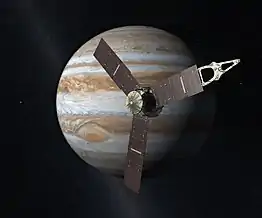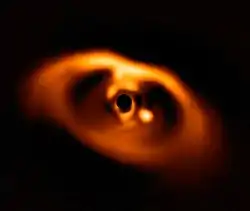Kepler-1647b
Kepler-1647b (sometimes named Kepler-1647(AB)-b to distinguish it from the secondary component) is a circumbinary exoplanet that orbits the binary star system Kepler-1647, 3,700 light-years (1,100 pc) from Earth in the constellation Cygnus.[2] It was announced on June 13, 2016 in San Diego at a meeting of the American Astronomical Society.[2] It was detected using the transit method, when it caused the dimming of the primary star, and then again of the secondary star blended with the primary star eclipse.[3] The first transit of the planet was identified in 2012, but at the time the single event was not enough to rule out contamination, or confirm it as a planet.[3] It was discovered by the analysis of the Kepler light-curve, which showed the planet in transit.
_b.png.webp) Kepler-1647b | |
| Discovery | |
|---|---|
| Discovery site | Kepler Space Observatory |
| Discovery date | June 13, 2016 |
| Transit | |
| Orbital characteristics | |
| 2.7205 ± 0.007 AU (406,980,000 ± 1,050,000 km)[1] | |
| Eccentricity | 0.0581[1] |
| 1107.6±0.023[1] d | |
| Inclination | ~90.1[1] |
| Star | Kepler-1647 |
| Physical characteristics | |
Mean radius | 1.06±0.0123 RJ |
| Mass | 1.52±0.65 MJ |
Characteristics
Mass and orbit
The exoplanet is a gas giant, similar in size to Jupiter, and has an orbital period of 1107 days.[3] This is the longest transit period of any confirmed transiting Kepler exoplanet discovered yet.[2] It is also the largest circumbinary Kepler planet known.[3] It is 483±206 times more massive than Earth, and 1.52±0.65 times Jupiter's mass.[1]
Host stars
The star system, Kepler-1647 (also known as 2MASS J19523602+4039222, KOI-2939, and KIC 5473556), is a binary star with the primary star (Kepler-1647 A) having a mass of 1.22 M☉, a radius of 1.79 R☉, and a surface temperature of 6210 ± 100 K. The secondary star (Kepler-1647 B), on the other hand, has a mass of 0.975 M☉, a radius of 1.79 R☉, and a surface temperature of 5770 K. In comparison, the Sun has a surface temperature of 5778 K.[4] The two orbit each other every 11 days.[5] The binary star system's age is estimated to be about 4.4 billion years old, about 200 million years younger than the Sun.
Habitability
Kepler-1647b is in the habitable zone of the star system.[2][3] Since the planet is a gas giant, it is unlikely to host life. However, hypothetical large moons could potentially be suitable for life.[2][3] Large moons are usually not created during accretion near a gas giant and would likely have to be captured separately, e.g., a passing protoplanet caught into orbit due to the gravitational field of the giant planet.
References
- "Kepler-1647b – NASA Exoplanet Archive". Retrieved June 14, 2016.
- "New Planet Is Largest Discovered That Orbits Two Suns". NASA. June 13, 2016. Retrieved June 14, 2016.
- Kostov, Veselin B.; Orosz, Jerome A.; Welsh, William F.; Doyle, Laurance R.; Fabrycky, Daniel C.; Haghighipour, Nader; Quarles, Billy; Short, Donald R.; Cochran, William D.; Endl, Michael; Ford, Eric B.; Gregorio, Joao; Hinse, Tobias C.; Isaacson, Howard; Jenkins, Jon M.; et al. (2015). "Kepler-1647b: the largest and longest-period Kepler transiting circumbinary planet". The Astrophysical Journal. 827 (1): 86. arXiv:1512.00189. Bibcode:2016ApJ...827...86K. doi:10.3847/0004-637X/827/1/86.
- Fraser Cain (15 September 2008). "Temperature of the Sun". Universe Today. Retrieved 19 February 2011.
- "Planet Kepler-1647 (AB) b", exoplanet.eu, 2 December 2015, retrieved 26 July 2019



